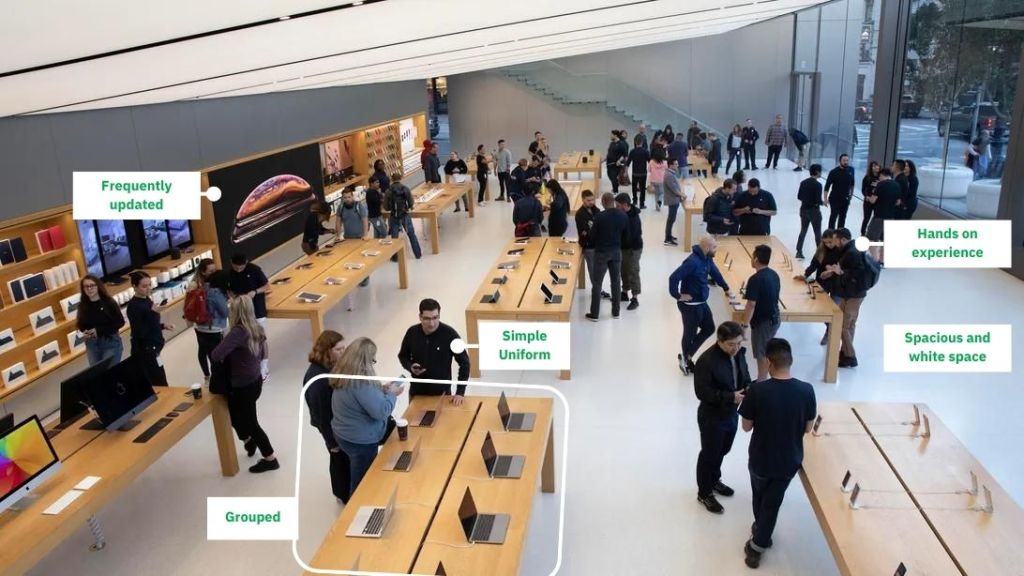

Human beings are inherently visual beings, with the majority of us primarily processing information through visual stimuli. In fact, research from the Social Science Research Network indicates that a significant 65% of individuals are visual learners.
Consequently, visual merchandising stands as a key element in the realm of retail. It serves a dual purpose: first, to enhance the appeal and enjoyment of your retail spaces, and second, to entice spontaneous purchases. As the landscape of consumer behavior has shifted towards online shopping in recent years, the importance of visual merchandising has escalated. Essentially, it revolves around the presentation and character of your store and brand; encompassing its aesthetics, atmosphere, and identity. When executed flawlessly, it contributes to the growth of brand loyalty among your customers.
Visual merchandising is a vital part of managing a retail store. It's all about how you present and make your store look visually appealing. It's like a blend of art and science aimed at making your products catch the eye of customers and, as a result, boosting sales. In simple terms, it's about creating an enjoyable shopping experience from before they enter your store, and after they leave
To achieve this, you use things like design, store layout, lighting, colors, signs, and product placement. These elements work together to shape the store's atmosphere and guide customers as they move around. The ultimate goal is to make your store not just a place to buy things but an environment that tells a story, reflects your brand, and even stirs up emotions in your customers.
Moreover, research from Forbes.com tells us that a large chunk of buying decisions, around 85%, actually happen while people are inside a physical store. This shows us how critical it is to have displays and product arrangements that really grab shoppers' attention.

From creating first impressions to outshining competitors, visual merchandising is the art that elevates the entire shopping journey. Let's uncover its significance.
| 1. Give a first impression 2. Convince to buy 3. pleasant shopping experience 4. Enhance Brand Consistency 5. Highlight Seasonal and Promotional Themes | 6. Create a Storytelling Experience 7. Cross-Sell and Upsell Opportunities 8. Attract the Target Audience 9. Competitive Advantage |
1. Give a first impression
Customers only have a few seconds to view your store and decide whether or not to enter your store. Therefore, store exteriors that are neatly arranged, attractive, and clearly explain the brand will attract buyers to enter your outlet.
Appearance, uniforms, lighting, menus, signage, colors, point of sale, and packaging are visual merchandise elements. By displaying these elements clearly and consistently, you can help customers understand your brand, leading to a positive shopping experience and eventually an increase in sales.
2. Convince the customer to buy the product she sees
A layout that optimizes the visual component of a product can lead to big sales. For example, when you go to a furniture store, do they display all the sofas in a row? Or instead, you find sofas, vases, tables, and armchairs arranged in a living room format? Helping customers imagine the product's appearance can actually help retailers increase sales. The look may also encourage customers who previously only wanted to buy a sofa to add a table that perfectly matches the sofa.
Place new products, special offers, and small items near the checkout queue at low prices. The correct position of the discount sign can also encourage customers to make impulse purchases.
Also read: 8 Powerful Visual Merchandising Strategies and Tips for Retail Store
3. Bring you a pleasant shopping experience
There's nothing worse than getting lost in a messy store. Overwhelming customers with products and offering too many choices often backfires in retail. Customers may feel overwhelmed, confused, and decide to leave the store. For this reason, retailers need to choose the right product to attract the target audience they want.
Signs in your store should be concise and clear. Too many signs and writing will make potential customers lose their way. Match the visual elements with your company branding. Use a font that is simple and easy to read from a distance. Not all products need to be displayed. Choose products that have the most appeal to be displayed in front and the center of the store. Analyze the available space to find out how much product you should display. Try placing products by color or category to make it easier for customers to find what they need. Show how the product can be helpful to the buyer.
4. Enhance Brand Consistency
Visual merchandising plays a vital role in maintaining brand consistency. It ensures that your store's appearance and atmosphere aligns with your brand identity. Ideally, when customers step into your store, they should instantly recognize and connect with your brand. This consistency builds trust and encourages customer loyalty.
To enhance brand consistency through visual merchandising, begin with a comprehensive style guide outlining your brand's visual identity; including color schemes, fonts, and design elements. Ensure that your store's physical layout and decor align with your brand's personality and values, while maintaining consistent color schemes and messaging. Train your staff to embody your brand's ethos; from uniforms to customer interactions, and regularly audit the store's adherence to brand guidelines. Use your store's design to visually narrate your brand's story, and listen to customer feedback for continuous improvement. Coordinate your online and offline presence and adapt to seasonal changes without compromising your brand's unique touch. This consistency fosters trust, recognition, and loyalty.

5. Highlight Seasonal and Promotional Themes:
Visual merchandising allows retailers to adapt to seasonal changes and special promotions. By strategically incorporating seasonal elements, holiday decorations, and limited-time offers into your store's layout and displays, you can attract customers who are looking for specific items during those times.
To effectively highlight seasonal and promotional themes through visual merchandising, begin by planning well in advance, establishing a clear calendar for upcoming events. Create distinct focal points within your store where seasonal and promotional products can take center stage, ensuring they capture customers' attention. Embrace thematic decor and immersive elements that reflect the essence of the season or promotion, drawing shoppers into the unique experience. Clearly and prominently display limited-time offers with compelling signage and placement to invoke a sense of urgency. Use storytelling displays that link these themes with your brand identity, and maintain consistent branding elements throughout to reinforce your store's identity. Lastly, gather feedback from customers to fine-tune your approach for future events and ensure it resonates with your target audience.
6. Create a Storytelling Experience:
Visual merchandising enables you to tell a story with your products. A well-crafted display conveys a narrative that resonates with customers on an emotional level. This storytelling approach can make shopping a more engaging and memorable experience, leading to increased sales and brand affinity.
Begin by selecting a compelling theme or narrative that aligns with your brand's values and resonates with your audience. Ensure that your product displays evoke emotions, create a memorable shopping experience, and guide customers through a captivating journey. Use props, lighting, and interactive elements to enhance the storytelling process. Consistency is key – maintain your brand's visual identity throughout the narrative to reinforce brand affinity. Customer feedback is invaluable for refining your storytelling approach and making it even more compelling.
7. Cross-Sell and Upsell Opportunities:
Effective visual merchandising can guide customers towards complementary products and upsell opportunities. By placing related items together or suggesting add-ons, you can increase the average transaction value and maximize revenue.
Start by strategically grouping related products together or recommending add-ons that enhance the customer's purchase. This approach increases the average transaction value and maximizes revenue potential. Consistent and appealing displays in key areas help direct customers toward valuable additional purchases, enhancing the overall shopping experience and benefiting your bottom line. Regularly analyze customer data and feedback to fine-tune your cross-selling and upselling strategies for optimal results.
8. Attract the Target Audience:
Visual merchandising isn't a one-size-fits-all concept. It's a flexible tool that lets retailers adjust their store's look and feel to cater to their specific audience. Whether you want to create a high-end, family-friendly, or tech-savvy atmosphere, visual merchandising is your ally.
Understand that there's no universal formula; instead, craft your store's atmosphere to match the preferences and requirements of your customers. Whether you're striving for sophistication, a welcoming family vibe, or a tech-savvy aura, visual merchandising empowers you to shape a shopping experience that resonates with your distinct customer base. By studying customer data and preferences, you can fine-tune your visual merchandising strategy, ensuring it remains in sync with your audience's ever-evolving needs.
9. Competitive Advantage:
In a competitive retail landscape, standing out is crucial. A well-executed visual merchandising strategy can provide you with a distinct competitive advantage; differentiating your store from competitors and positioning it as a sought-after shopping destination.
This not only boosts foot traffic but also drives increased sales, solidifying your position in the market. Keep an eye out for industry trends and customer preferences to maintain your competitive edge and keep attracting shoppers.
Apple Inc., the iconic tech giant recognized for its minimalistic retail stores, serves as a stellar example of effective visual merchandising implementation. Apple's retail experience stands as a testament to how strategic VM can elevate brand identity and foster customer engagement.
| Store Design and Product Presentation | Their products are elegantly showcased on simple tables, allowing customers to interact freely and encouraging a hands-on experience. |
| Embracing White Space | White creates an ambiance of simplicity and cleanliness; focusing customers' attention on the products. |
| Uniformed Staff | Apple's staff don simple, iconic uniforms, often featuring branded t-shirts and lanyards. |
| Digital Signage and Interactive Displays | Interactive displays enable customers to explore |
| Strategic Product Placement | Apple adeptly groups related products together |
| Innovative Presentation | When launching new products, they create visuals that capture customers' imaginations |
| Regular Updates | Apple stores are known for their frequent visual refreshes |
Apple stores boast a clean, spacious layout. Their products, including iPhones, iPads, MacBooks, and accessories, are elegantly showcased on simple tables, allowing customers to interact freely and encouraging a hands-on experience.
Apple's use of white space is a key VM feature. White tables, walls, and ceilings create an ambiance of simplicity and cleanliness; focusing customers' attention on the products. This design choice aligns seamlessly with Apple's image of sophistication and innovation.
Apple's staff don simple, iconic uniforms, often featuring branded t-shirts and lanyards. These uniforms serve both a functional and aesthetic purpose, contributing to the store's overall look.
Apple stores employ digital screens for product information and demonstrations. Interactive displays enable customers to explore device features, fostering a sense of product discovery and ownership.
Apple adeptly groups related products together, making it convenient for customers to find everything they need in one place, such as iPhones and their associated accessories.
Apple's VM team consistently innovates in product presentation. When launching new products, they create visually striking, high-impact displays that capture customers' imagination.
Apple stores are known for their frequent visual refreshes, ensuring that the shopping experience remains dynamic and enticing, which encourages repeat visits.

In conclusion, Apple's visual merchandising triumphs go beyond aesthetics, creating an environment where customers engage with products in a unique and captivating manner. It stands as a prime example of how effective VM can firmly establish a brand's identity, draw in customers, and boost sales. This iconic brand's retail approach showcases the profound impact of a commitment to exceptional visual merchandising, resulting in a loyal customer base and consistent business growth.
Well, now you know the importance of visual merchandising. Has your retail business implemented it? If not, immediately make a visual merchandising plan for your retail outlets. If so, have you ensured that the implementation of the visual merchandising daily is according to the original plan? Creating a visual merchandising plan isn't always easy, but applying the plan consistently can be even more difficult if you don't use the right technology. But, you don't have to worry. Now there's Nimbly that can help you monitor product placement and decor in your outlets. With Nimbly, you can reference the correct product placement, and when performing a retail audit, have your team in the field check and correct the product placement as per the references.
